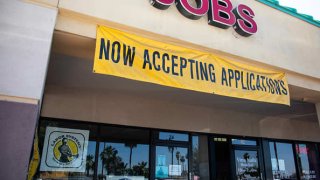
- Recent JOLTs data put U.S. job openings in April at a record 9.3 million, but this is running alongside persistent unemployment and subdued hiring rates.
- The labor shortage has forced some companies to raise wages and offer more attractive bonuses, and prompted some state officials to declare an early end to enhanced unemployment benefits.
- In a note to investors Monday, Goldman Sachs said it expects the labor force participation rate to recover more quickly in the coming months as unemployment insurance benefits expire.
The quickly tightening labor market could present a problem for financial markets in the medium term, according to Longview Economics CEO Chris Watling.
Recent JOLTs data put U.S. job openings in April at a record 9.3 million, but this is running alongside persistent unemployment and subdued hiring rates. The most recent jobless claims data showed a surprise jump during the week ended June 12, despite vacancies continuing to surge as the economy reopens.
Corporations have also publicly decried a shortage of available workers, citing child-care issues, ongoing fears about the pandemic and the lure of enhanced unemployment benefits due to government stimulus programs.
Get top local stories in Southern California delivered to you every morning. >Sign up for NBC LA's News Headlines newsletter.
The labor shortage has forced some companies to raise wages and offer more attractive bonuses, and prompted some state officials to declare an early end to enhanced unemployment benefits.
Speaking to CNBC's "Squawk Box Europe" on Tuesday, Watling suggested that the labor market would continue to tighten and could "upset the apple cart"as far as the Federal Reserve's commitment to its accommodative monetary policy stance goes.
Money Report
"This is a shock we are coming out of, not a recession. The scarring that we had in the recession post-financial crisis is not going to be the issue today," he said, arguing that the key question will be whether inflation continues to run hot and causes the Fed to change course.
The central bank recently upped its inflation outlook and brought forward its interest rate hike schedule, now projecting two hikes in 2023, as inflation runs at multi-decade highs.
"At the moment they seem pretty resolute on sticking the course — looser for longer, looser than they have ever been — and maintaining that liquidity as much as they can, and being very very slow to withdraw it," Watling said.
"Anything that upsets that apple cart, and the labor market is a possible candidate, is a real issue I think for financial markets in the medium term, given the sort of valuation metrics that we have there."
Labor force participation rate recovery
In a note to investors Monday, Goldman Sachs said it expects the labor force participation rate to recover more quickly in the coming months as unemployment insurance benefits expire. However, Goldman economist Joseph Briggs suggested it is unlikely to retrace the 1.8 percentage point decline since the start of the pandemic.
The LFPR is a measure of the economy's active workforce, charting the proportion of those employed or actively seeking employment within the total non-institutionalized population.
"Early retirements have depressed the LFPR by about 0.5pp, adding to the roughly 0.2pp structural drag from population aging since the pandemic began, and these exits will likely prove permanent," Briggs said.
"But the good news is that most labor force exits by prime-age and younger workers, currently a 0.6pp drag on the LFPR, look temporary. The share of these workers who say they don't want a job is fairly modest, and most labor force exiters who want a job haven't searched recently, suggesting that they will reenter once temporary disincentives to work disappear."
Goldman expects the LFPR to rise from 61.6% in May to a peak of 62.6% by the end of 2022, 0.8 percentage points below its pre-pandemic level.
Briggs also noted that a collapse of immigration had reduced the labor force by an additional 750,000 workers, of which Goldman expects a 300,000 drag to endure.
"After adding this immigration hit to other drags, we estimate the labor force will remain over 1.2mn workers below trend by the end of 2022," Briggs added.






